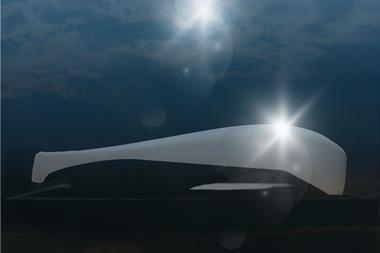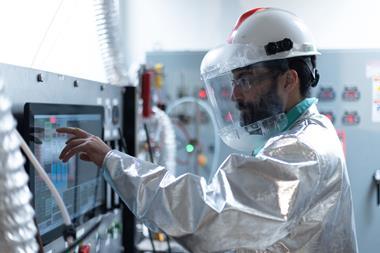Once the domain of high-performance sports cars, recent developments have increased composite use in high volume manufacturing
There are two very distinct parts of the automotive industry; those two sectors have vastly differing challenges and have approached the use of composites in differing ways. We are, of course talking about the high volume sector and the low volume niche manufacturers.
In the high volume sector, a large percentage of the cost is in the capital plant needed for manufacture, so once the required equipment has been procured and commissioned it is very costly to change the design of a component. This naturally makes the industry very conservative and encourages extensive prototype testing in both real and simulated environments of any new system before the investment is made. In small-volume production, however, the manufacturing operations are much less capital intensive, so the resistance to change in materials is somewhat less.
The main advantages composites offer the automotive applications are in cost reduction, weight reduction and recyclability. Composites offer many structural and weight advantages over traditional steel and injection moulded automotive parts.
Moving from custom components for low volume, highperformance vehicles to mass market cars presents several challenges to composite manufacturers. “Mass producing carbon composite cars, family vehicles with a body shell or even chassis constructed of carbon fibre, is the ambition of many automotive manufacturers and engineers,” explains Matt Cox, founding director at URT Group.
“Progress, however, will largely depend on advancements made by the composite engineers that carmakers partner with.” According to Cox, they should be concentrating on driving down costs, cutting production times and ensuring quality. “The majority of composite components produced are currently too expensive for mass production for two reasons: the cost of raw materials; and the production time required,” he says. “High production costs are also due to the relatively slow process of producing a component. It takes approximately 90 minutes to manufacture a simple carbon fibre body panel, such as a bonnet or boot lid, something that takes a matter of minutes for a similar steel panel. So, to reduce costs, manufacturers should also be cutting production times.”
Cox explains that there is no single solution to improving the efficiency of composite component production. Rather, a variety of methods should be developed for specific types of product. “A major cause of lengthy production times is the autoclave curing process which will, on average, take an hour. By using high temperature snap-curing autoclaves, the process could be cut to around 17 minutes. By using quickcuring systems and out-of-autoclave production lines, this could be cut to 5-7 minutes – a short enough process to make mass production feasible, he says.” A lot of discussion appears to be hinged around pressed components, but this is not necessarily the best and final option. Bespoke tooling with integrated pressure gains engineered for part-bypart requirements could be the key. No one part is the same, so why should it be manufactured in the same method?
“In addition to this, as an industry we need to reduce the scrap element of woven fibres. Short strands are an option but this adds weight and the limited ability to engineer them due to their random nature,” Cox says. “One solution could be bespoke knitted structures in both manipulated 2D and full 3D.”
When it comes to the variety of new technologies being trialled on the production line, the challenge will be to maintain the levels of quality while dramatically reducing production times. Methods will vary but the key to success will continue to be the manufacturer’s inherent attention to detail and desire for perfection.
 One company that has a strong reputation in using composites and other lightweight materials is Audi. To further develop its use of composites, the German carmaker looked to Voith Carbon for expertise, in particular with fibre-reinforced polymers (FRP).
One company that has a strong reputation in using composites and other lightweight materials is Audi. To further develop its use of composites, the German carmaker looked to Voith Carbon for expertise, in particular with fibre-reinforced polymers (FRP).
Fibre-reinforced plastic (also fibre-reinforced polymer) is a composite material made of a polymer matrix reinforced with fibres. The fibres are usually glass, carbon, basalt or aramid, although other fibres such as paper or wood or asbestos have been sometimes used. The polymer is usually an epoxy, vinylester or polyester thermosetting plastic, and phenol formaldehyde resins are still in use. FRPs are commonly used in the aerospace, automotive, marine, and construction industries.
FRP allows the alignment of the glass fibres of thermoplastics to suit specific design programs. Specifying the orientation of reinforcing fibres can increase the strength and resistance to deformation of the polymer. Glassreinforced polymers are strongest and most resistant to deforming forces when the polymer’s fibres are parallel to the force being exerted. They are weakest when the fibres are perpendicular.
“We decided about three years ago to seek an external partner with whom to address the new task,” says Dr Lutz- Eike Elend, head of the Audi Lightweight Design Centre. “We looked around first in the aviation industry but recognised very quickly that, although there is a great deal of know-how in the sector, there was only limited willingness to rethink the manufacturing structures. Voith, on the other hand, is a strong equipment manufacturer that approaches the issue of fibre-reinforced polymers in a very open and forwardlooking manner.”
“We are starting at the moment with the fibre mats that we buy from an external supplier,” she continues. “Audi and Voith are not chemical companies; we are not interested in manufacturing the fibres ourselves and thus committing ourselves to one specific material. What we want to do first is master the production of the components and gain knowledge on which materials, semi-processed parts and production processes are suitable for possible high volume applications. Furthermore, we would like in future not to buy the fibres and semi-processed parts – the webbing and mats – off the shelf, but instead to tailor them to our needs.”
 According to Dr Lars Herbeck, CEO of Voith Composites, basalt fibres are relatively easy to work with and can be used to make parts with thermal insulation properties. “We could achieve the integration of a new function and dispense with, for instance, protective panels,” he says. “Natural fibres are becoming increasingly interesting because of CO2 considerations. And glass fibre is obviously an attractive and relatively cost-effective material for many areas of application.”
According to Dr Lars Herbeck, CEO of Voith Composites, basalt fibres are relatively easy to work with and can be used to make parts with thermal insulation properties. “We could achieve the integration of a new function and dispense with, for instance, protective panels,” he says. “Natural fibres are becoming increasingly interesting because of CO2 considerations. And glass fibre is obviously an attractive and relatively cost-effective material for many areas of application.”
The FRP pilot line that Voith commissioned a few months ago in Garching, near Munich, complements Audi’s technical centre in Neckarsulm in a very targeted manner, as it uses other technologies in areas such as cutting equipment and the RTM (resin transfer moulding) press.
“The process of choice is always dependent upon the functional characteristics of the components, the volumes and the cost,” Dr Elend adds. “When it comes to the volumes we are addressing currently and over the next few years, we prefer the RTM process, where we are seeking to reach a process interval of less than three minutes. However, when you think beyond that to more than 100,000 vehicles per year, you have to consider other technologies like hot pressing.”
Audi models such as the R8 and A8 are its technology showcases, in which the boundaries are stretched somewhat further. “When it comes to the high volume models, economical factors obviously play a more important role,” Eland adds. “But by the year 2020, I can certainly envisage fibre components in the mid-size class or even in certain areas of the compact class. We are making the entire materials portfolio accessible; we are combining all materials into our multi-material spaceframe in order to create a feasible overall concept. In parallel, we are also establishing extensive expertise in the field of joining technology.”
In CFRP (carbon-fibre-reinforced polymer), the fibres account for 80 to 90% of the material cost, which is why Voith is working with Audi on new, more cost-efficient, semi-processed material supplies. “If we successfully manage to manufacture the parts cost-effectively and quickly, then CFRP and other FRP materials will have a great future,” Herbeck says. “With higher volumes, we can then work on building a real mass-production system.”
The current focus at Audi is on using composites for the bodyshell but Elend expects further uses to evolve in time. “Yes, the R8 e-tron for example has a battery casing and crash structure made from CFRP,” he says. “On the R18 Le Mans race cars, the transmission casing is made from the same material. The fascinating thing about the new fibre materials is functional integration. Our e-tron models in particular call for a fundamentally new approach to the layout of the bodyshell architecture, which offers all sorts of possibilities.”





































